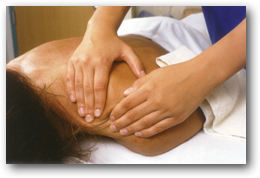Myofascial Release
Myofascial release therapy uses hands-on stretching and massage of the entire body to promote healing and relieve pain. Therapists use the technique to ease pressure in the fibrous bands of connective tissue, or fascia, which encase muscles throughout the body. Sheaths of this dense and elastic connective tissue weave around and between blood vessels, bones, and nerves.
 Myofascial release therapy is based on the idea that poor posture, physical injury, illness, and emotional stress can throw the body out of alignment and cause its intricate web of fascia to become taut and constricted. Also, the fascia may bind to underlying tissues, causing “adhesions,” or dabs of scar tissue that cling to muscle fibers. Even though these adhesions do not show up on X-rays or other scans, they can stiffen joints or contribute to painful motions, such as rotator cuff injuries. If they occur near a nerve, they may cause numbness, pain, and tingling, as with sciatica or carpal tunnel syndrome. The gentle and sustained stretching of myofascial release is believed to free these adhesions and soften and lengthen the fascia.
Myofascial release therapy is based on the idea that poor posture, physical injury, illness, and emotional stress can throw the body out of alignment and cause its intricate web of fascia to become taut and constricted. Also, the fascia may bind to underlying tissues, causing “adhesions,” or dabs of scar tissue that cling to muscle fibers. Even though these adhesions do not show up on X-rays or other scans, they can stiffen joints or contribute to painful motions, such as rotator cuff injuries. If they occur near a nerve, they may cause numbness, pain, and tingling, as with sciatica or carpal tunnel syndrome. The gentle and sustained stretching of myofascial release is believed to free these adhesions and soften and lengthen the fascia.
Whereas muscles often respond to the firm strokes and thrusts of massage, fascia is thought to respond to a much milder touch. And unlike a typical chiropractic manipulation, which focuses on improving the motion and function of a particular joint, myofascial release works on a broader swath of muscles and connective tissue. The movements have been likened to kneading a piece of taffy – a gentle stretching that gradually softens, lengthens, and realigns the fascia.
In addition to back pain, myofascial release is used to treat a wide array of painful ailments affecting the muscles and connective tissues. These include fibromyalgia, rheumatoid arthritis, muscle spasms, whiplash injuries, and carpal tunnel syndrome. People with diabetes, who are at increased risk for painful plantar fascilitis and frozen shoulder, may also benefit. Athletes have used the technique for stress injuries such as tennis or golfer’s elbow, shin splints, or a bad sprain that is having trouble healing.

